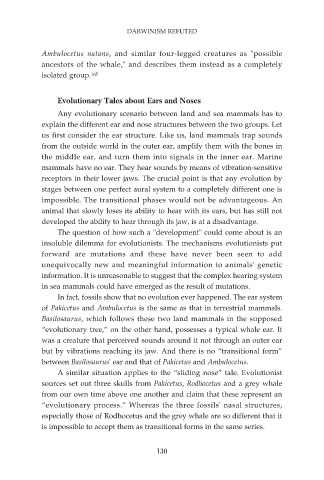Page 132 - Darwinism Refuted
P. 132
DARWINISM REFUTED
Ambulocetus natans, and similar four-legged creatures as "possible
ancestors of the whale," and describes them instead as a completely
isolated group. 165
Evolutionary Tales about Ears and Noses
Any evolutionary scenario between land and sea mammals has to
explain the different ear and nose structures between the two groups. Let
us first consider the ear structure. Like us, land mammals trap sounds
from the outside world in the outer ear, amplify them with the bones in
the middle ear, and turn them into signals in the inner ear. Marine
mammals have no ear. They hear sounds by means of vibration-sensitive
receptors in their lower jaws. The crucial point is that any evolution by
stages between one perfect aural system to a completely different one is
impossible. The transitional phases would not be advantageous. An
animal that slowly loses its ability to hear with its ears, but has still not
developed the ability to hear through its jaw, is at a disadvantage.
The question of how such a "development" could come about is an
insoluble dilemma for evolutionists. The mechanisms evolutionists put
forward are mutations and these have never been seen to add
unequivocally new and meaningful information to animals' genetic
information. It is unreasonable to suggest that the complex hearing system
in sea mammals could have emerged as the result of mutations.
In fact, fossils show that no evolution ever happened. The ear system
of Pakicetus and Ambulocetus is the same as that in terrestrial mammals.
Basilosaurus, which follows these two land mammals in the supposed
“evolutionary tree,” on the other hand, possesses a typical whale ear. It
was a creature that perceived sounds around it not through an outer ear
but by vibrations reaching its jaw. And there is no “transitional form”
between Basilosaurus' ear and that of Pakicetus and Ambulocetus.
A similar situation applies to the “sliding nose” tale. Evolutionist
sources set out three skulls from Pakicetus, Rodhocetus and a grey whale
from our own time above one another and claim that these represent an
“evolutionary process.” Whereas the three fossils' nasal structures,
especially those of Rodhocetus and the grey whale are so different that it
is impossible to accept them as transitional forms in the same series.
130

